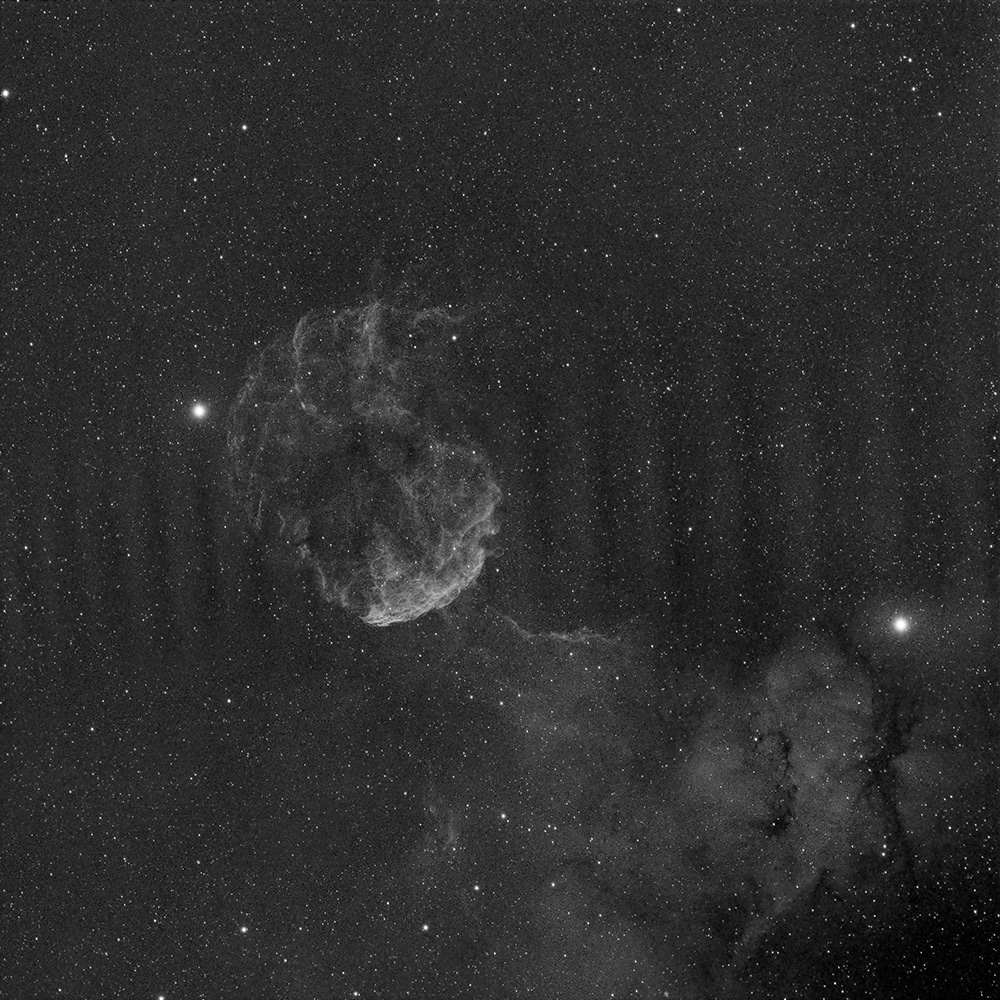The Jellyfish Nebula, otherwise known as IC 443, is a supernova remnant in the constellation of Gemini. It has 2 enormous stars around it called ηGem (right) and μGem (left).
Shooting the Jellyfish Nebula
I shot this over 4 nights, doing 1 signal per night (Ha, Oiii, Sii, RGB). It’s about 10+ hours of data, which is not that much for 4 nights, but I had a few problems with clouds etc. that resulted in tossing several subs.
Hydrogen-Alpha Issues
There was a big problem when I did my first go-round of processing with the Jellyfish Nebula. The Hydrogen-Alpha (Ha) that I shot 2 weeks before-hand had spots all the way across it resembling open blinds on a window (see photo below). The issue wasn’t noticeable on the individual subs while shooting, but once I stacked them, the open blinds were so apparent. Despite trying many methods to eliminate those weird spots, nothing proved successful. My only choice was to toss the 3 hours of data.

I definitely shot flats alongside this photo, and there was nothing in the flats that showed the pattern in the photo above. If anybody knows what may have caused this issue, please let me know! Similar issues have happened before, but this one was odd, especially because it was Ha and Ha at 3nm blocks out a ton of light. The only unique thing about that night was snow on the ground, but I’ve had snow on the ground many times and have never encountered an issue like this.
Processing IC 443
In Pixinsight, I used my typical process of dynamic crop, DBE, Blur Exterminator, multi-scale linear transform, and histogram transformation. I then combined them in Pixelmath using dynamic narrowband combinations and applied a bunch of curves transformations which increased contrast, saturation, etc.
LRGB Combination & Using Ha as Luminance
I used the Ha channel as a luminance channel and applied an LRGB combination to the image to make it pop more. If you’ve never done that, do it! It’s one of the major benefits of shooting mono. I could never achieve that pop shooting color that adding Ha back on to the image achieves with mono. Sure, you can extract Ha from a color image if you used an Optolong L-Extreme (or L-Ultimate), but it’s just not the same. Compare the 2 images below of before applying Ha as luminance and after applying Ha as luminance by rolling over it. The difference is unbelievable.
Before LRGB Combination
After LRGB Combintion
Using Morphological Transformation in Pixinsight
Morphological Transformation has to be the dorkiest name the creators of Pixinsight ever gave a process. It sounds like something out of a Kafka novel (The Metamorphosis maybe?). For something that sounds so daunting, its function is quite simple–it reduces the stars in your photo either by shrinking them or completely erasing them.
I shot this with a Redcat 51 and ASI533MM, which resulted in an under-sampled image (and a lot of stars and noise). A lot more than my 644mm scope (which is perfectly sampled) would give me. I used a drizzle integration with a droplet size of .5x and 2x scale to smooth out what may have been square-ish stars. Despite this, I still felt the star field was overwhelming and caused a distraction to viewing the primary subject–the Jellyfish Nebula. Taking away stars makes me feel like I’m cheating, but in this case, the under-sampled Redcat 51 was the issue and correcting the star field was doing it a service.
In the example below, you can rollover the image to see the effects of morphological transformation on IC 443.
Before Morphological Transformation
After Morphological Transformation
Conclusion
The Winter is full of amazing objects to shoot and I’m actually surprised I took the time to shoot the Jellyfish Nebula when we have so many intriguing targets like M42, The Horsehead Nebula, California Nebula, etc. I did always want to shoot this. Next time, I’d love to capture a super wide field of this with the Monkey Head Nebula. I will have to do a mosaic or get a wider field setup.
View this on Astrobin for more information about integration time.
